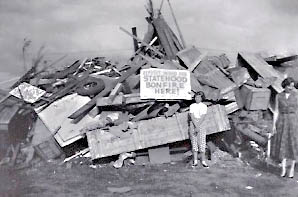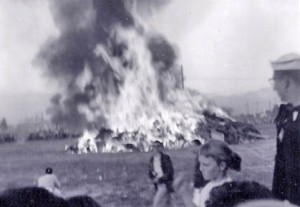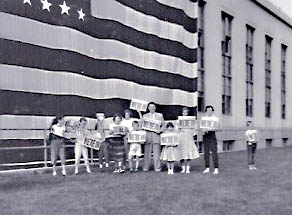Does the date June 30, 1958 mean anything to you? For most of us it is utterly insignificant. But to a select few the date stands out as a landmark in history. On that date, the Alaska Statehood bill passed the US Senate with a vote of 64-20.
Although President Eisenhower signed the Alaska Statehood Law on July 7, 1958, she officially became a state on January 3, 1959. It marked the end of a decades long struggle to move from territorial status to that of the 49th State.

I was sixteen, having just finished my sophomore year at Anchorage High School and I thought this event was just about the most exciting thing that had ever happened in my life, with the exception of July 9, 1953 when Mt. Spurr erupted and dumped what seemed like a ton of ash on Anchorage. Or when President Eisenhower visited and everyone stood on Fourth Avenue to wave at his motorcade, and then rushed over to Fifth Avenue to wave at him again. He probably assumed there were twice as many people in Anchorage than there really were.
There is a considerable amount of information on the Web on how vigorous and lengthy the fight was to gain statehood. Google it and you will find it. But that’s not the story I want to tell you. I want to tell you how it felt to be there on that significant day.

During high school I belonged to an international pen pal organization called Youth of All Nations (YOAN). I wrote my first published piece for their international newsletter, Mirror For Youth, and the article was published in the fall of 1958. Missing all the edits I wish I could make now, it follows directly from my then sixteen year-old heart and pen:
“I always said that I would be in Alaska when it became a state. And I was! I don’t think I’ll ever forget June 30, 1958. All morning long radios all over Anchorage were kept on in hopes that June 30th would be the day that statehood was passed.
“I was downtown that afternoon, and standing in a jewelry shop when a clerk rushed up and said, ‘Well, we’ve done it. We’re a state now!’ It was 2:15 p.m. Sirens went off and guns were fired.
“There was a joyous ceremony in front of the post office, where an outsized American flag was draped over the side. A huge, glittering gold star was placed upon it, to ‘blanket Texas.’ And there were shouts and cries that ‘Now we’re the biggest state!’ and ‘We’ve covered up Texas!’
“I heard one man ask a younger one, ‘Have you ever voted for a president of the United States?’ The young man shook his head. ‘Well, you’re going to be able to now!’ was the reply.
“It was fun to walk around that afternoon and see what was going on. Almost everyone had a camera, and the streets were crowded with people from every profession and walk of life. I don’t believe I had ever seen ‘downtown’ so full of people. I had never seen so many cars in Anchorage at one time, and I’ve been here almost ten years. It was one traffic jam after another. I know a woman who needed an hour and a half to drive about six blocks!
“That evening there was an enormous bonfire in the middle of the city park.
“It is one thing to say you saw something, and another to say you participated in it. The director [Jack McGuin] of the band and majorettes of Anchorage High School (mine) asked the band members and majorettes (even the alumni) to participate at the bonfire. As I’m an acrobatic baton twirler, I went too. We entertained for awhile, then stopped to watch the festivities.

“The bonfire was lit with torches carried by Boy Scouts, then a cannon was fired 50 times, the last time for Hawaii. Afterwards there was folk dancing and snake dancing. But I haven’t mentioned the Alaska cowboys, riding their horses around and around the burning fire, or the Shriners’ and Air Force bands, or all the firecrackers and cherry bombs that were going off.
“Well, soon we’ll be the 49th state, legally. In a way, it will be a bit disappointing. It was fun to be able to say that you belonged to a territory, that you were a little different from every other American. But, for the good of Alaska, I’m glad we will soon be a state, for that is what Alaska needs.
“I hope that the people in the states, what am I saying! I should say ‘the people of the other states’ will learn a lot about their great new ‘sister’; for Alaska is so misunderstood. I hope they’ll learn that we don’t live in igloos, and that, believe it or not, we do go swimming in the summer in Alaska’s beautiful blue lakes.

“Sometimes I get so proud that I live here that I want to tell the whole world about it. For Alaska is the land for the young and strong to build into a greater land. Yes, now that we are soon to be a state, we will have new responsibilities and duties ahead of us. But Alaska will come out ahead, because her people are strong and able.
“In closing I would like to say to all YOANers and everybody else, too, ‘don’t just read about Alaska! Come and see our ‘Last Frontier’ for yourselves. You’ll be glad you did.’”
I smile while I read this, 55 years down the road from the musings of my sixteen year-old-self. Am I still that wide-eyed and naive? Not by any means. But there is one thing that I do know: I am still wildly and emotionally passionate about the Great Land, even after all these years.

Jana Ariane Nelson (nee Janet Griffith) moved to Anchorage in 1948 with her parents, Donald and Denney Griffith, and her twin brother, Jack.
Jana worked in the legal field in Anchorage before moving to Oregon. She retired from Lane Community College in Eugene where she was the Mathematics Division Coordinator.
Her daughter, Naomi Sweetman, is the Alaska DARE Coordinator and her son, John Nelson, is a financial advisor for Merrill Lynch in Anchorage. Jana has 4 grandchildren and one great grandchild in the Anchorage area. Her brother, Jack, runs the Griffith Lab at the University of North Carolina.
For more stories of early Anchorage, visit growingupanchorage.com.




